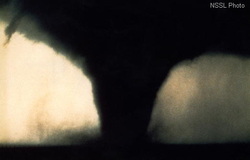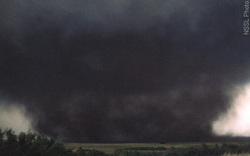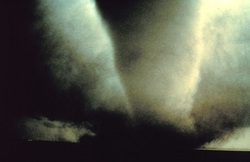
On June 19, 1794 a violent and powerful weather system brought severe weather to the northeast United States. In the Hudson Valley a large tornado roared across the Hudson River and into Poughkeepsie. It did extensive damage as it roared across Dutchess County into Connecticut. I have not been able to find a rating of the tornado as it was before modern weather measurements; however, from what I can tell from the descriptions it had to be at least an EF3 tornado.
The following excerpts are from individuals that witnessed the tornado in 1794. The language is archaic but captivating to read. These primary sources offer us a view into the terror and chaos that this storm created in the area.
The following excerpts are from individuals that witnessed the tornado in 1794. The language is archaic but captivating to read. These primary sources offer us a view into the terror and chaos that this storm created in the area.

Photo of a large tornado.
The most terrible wind that had been experienced in western Connecticut since its first settlement passed over a portion of the country at about five o'clock on the afternoon of Thursday, June 19, 1794. Its general direction was from the northwest to the southeast. It first appeared in Poughkeepsie, N. Y., where it blew down several buildings, and destroyed other property. In Connecticut it passed through the towns of New Milford, Newtown, Watertown, Waterbury, Northford and Branford.
Before anything unusual appeared in the heavens a peculiar sound was heard in a westerly direction. After the noise had continued for several minutes a dense, dark cloud appeared over the hills. As it approached it seemed like an immense body of smoke or fog, and at length it was discovered to be in a state of extreme agitation, wreathing in and out and whirling in the most furious manner. The foremost part of the cloud had the appearance of a common thunder cloud, being thick and heavy, but not very dark. Its height and width were about an eighth of a mile either way. We have said its width, but diameter would be more correct as the cloud was round. It whirled along like a cylinder revolving perpendicularly. Those who saw it directly in front, and only six or eight rods away, said that innumerable streaks of fire ran across it in every direction, and at a distance the cloud seemed to lighten up now and then. It was supposed by some people at the time that the light was due to friction caused by the articles that were revolving with great rapidity in the vortex of the cloud, among which were the herbage of the field, parts of fences, leaves, boughs and trunks of trees, boards, doors, barrels, clothing, live geese and other fowls and birds. The centre of the cloud was clear air. At Northford it seemed to divide into several smaller whirlwinds, yet forming one complete cylinder of air and cloud. The vortex contracted and increased in diameter at several periods of its progress. When it contracted its force seemed to lessen, and as it grew larger it became correspondingly more frightful and disastrous.
Its course was irregular, and it travelled with great rapidity and in the wildest confusion. Its path, though well defined, greatly varied in width. It was very narrow on the highlands, but when the cylinder of cloud and whirling wind descended a hill it seemed to spread out like a flood of waters rushing down with a velocity that constantly increased, and became quite wide when it reached the valley. As it approached, the noise became louder until it rumbled like the roar of an earthquake. Those persons who were carried up by the wind into the cloud and yet escaped with their lives said that it was as dark as night during the three or four minutes they were in it, and that the noise was deafening and awful. Those who were quite near- it, and yet escaped said that it appeared to them most fearful and sublime. After the column of wind had passed by, a little rain fell from the rear end of the cloud, accompanied by a small amount of hail.
The destruction occasioned by the wind was most disastrous, many houses, barns, and other buildings being blown to pieces, a number of cattle killed, and several human lives lost. Orchards and forests yielded to its irresistible power, and strong oaks, sturdy maples and elastic walnuts were torn up by the roots or twisted off leaving stumps from three to fifteen feet in height. Every fence and stone wall in its course was demolished.
On either side of the path of the whirlwind the air was calm. An incident showing this is thus related. A gentleman was quietly sitting in the stoop of his house, unconscious that such a terrible messenger of destruction was so near him, when without feeling the force of the wind in the least, he was amazed to see his bam, which stood but about four rods from his house, lifted up and moved off its foundations.
At New Milford, the whirlwind came into the town on the northwest side and passed through in a southeasterly direction. Fortunately its course lay just outside the village, as it there encountered, few dwelling houses and other buildings. It made broad paths through extensive tracts of woodland, that were visible as far as the eye could reach. Timber trees of various kinds and sizes and of great strength were prostrated, being broken down or torn out of the ground by the roots. A few cattle were killed by falling trees and timbers from demolished barns. Three houses were wholly destroyed, and twelve were unroofed and much shattered. Eight barns were snatched from their foundations and torn to pieces.
Benjamin Stone, jr., saw the cloud approaching, and being aware of its terrible import, he took his four children (his wife being away from home) and hurried to his new, strong barn, which he thought would withstand the wind. The building was but a few rods away, and they had time to reach the bay in it before the whirlwind struck the place. But Mr. Stone was wrong in his estimate of the wind's force, the barn tipped over, and he and the children were carried under the sills into the yard, amid timbers and fragments of trees that were moving hither and thither in great confusion. They escaped, however, with only slight wounds. Mr. Stone's house was stripped of all its shingles, clapboards, boards and windows, leaving the frame bare, and several of the timbers were also scattered about. All the contents of the house above the lower floor,- furniture, clothing, and provisions, were carried away, scarcely anything being found that was still whole, and many of the articles were never seen again. A purse containing sixteen dollars, that was kept in a case of drawers was found eight or ten rods away. The residence of Thaddeus Cole was torn into fragments. When the whirlwind struck the house there were in it Mrs. Cole and her infant child, and a Mr. Tucker, who were all buried in the ruins. The neighbors discovered their condition, and with willing hands they hurried to relieve them, but an hour elapsed before they could be extricated. The child was found dead, having been killed in its mother's arms, Mrs. Cole was greatly bruised, and Mr. Tucker was so severely injured that for a long time it was supposed he could not recover.
John Carpenter was in a field with five or six hired men and two of his sons, one of whom was eleven years old, and they were suddenly overtaken by the whirlwind. They immediately fell on their faces, and, grasping the herbage of the field, clung to it while the furious wind repeatedly raised their bodies up and let them fall upon the ground, bruising them considerably. Fence rails and parts of trees fell thickly about them. Mr. Carpenter was wounded in his back by a rail, and his younger son had his head beaten two inches into the ground, almost mortally wounding him. Mr. Carpenter's horse was whirled into the air, being carried twelve rods up a steep hill, where he struck with so much force that his body indented the ground to the depth of five or six inches. He was then whirled back, nearly the same distance, being found dead at about the same place where he was first attacked by the terrible wind. Another horse, that was hitched to a post, was carried over a stone wall into a field of wheat, a distance of forty or fifty rods. A new ox-cart was completely broken into pieces, which were scattered in all directions. One of the wheels with the axle-tree was found about three rods away, and the other wheel was carried two or three rods further, being forced some distance into the ground. The body of the cart was found four or five rods farther away and an iron washer that had belonged to it had been carried a rod or two beyond. The water in a large brook was also taken up and distributed over an adjoining field. Several large trees were carried from thirty to sixty rods. A hackmatack, or tamarac, tree was taken up by the roots, and carried along in its natural position. At times it would descend nearly to the earth, then rise with great rapidity to the height of some three hundred feet. Appearing to play around it were two or three large objects that were supposed by the people who witnessed the scene to be barn doors. They attended the tree in all its evolutions until it disappeared from sight. One barn door was found eight or ten miles from the place where it was snatched up by the wind. A heavy oak log, fifty feet long, and nine inches in diameter at the small end, was lying on the lower side of a road which ran along the slope of a steep hill, and a smaller log lay on one end of it. The two logs were taken up by the wind and carried to the other side of the road. At Newtown, several houses and barns were blown down, and its effects were also severely felt in Watertown and Waterbury. In Northford, the whirlwind providentially passed over a portion of the town that had but a scattering population, and therefore did not destroy many buildings or injure any persons in its course. Several buildings were however removed from their foundations, and some were torn to pieces. It did considerable damage in the destruction of forest and fruit trees, and sugar maples. It was also felt at Branford, and probably ended its disastrous career on the Sound.
Source: Historic Storms of New England by Sidney Perley, 1891

On Thursday afternoon, 19th inst. passed over this place a cloud out of the S.W. the head of which was very thick and heavy, like the common thunder cloud; but of a very light smoky colour and agitated beyond description. It’s height and diametrical extent about one eighth of a mile; of a circular figure, whirling in a most violent manner from its center. From its center issued a vortex of air, (similar to what is often seen in water) which descended to the earth, and alternately increased from 1 to 2 rods apparently, but really from 5 to 20. As I stood and viewed it, at times it appeared to divide into a number of whirls, yet all complete in one. This vortex had constant communication with the cloud above, and when it contracted (the vortex) the wind lulled a little, but when it expanded, frightful to behold!
The herbage of the field, the fowls of heaven, fences, leaves, boughs and trunks of trees filled the atmosphere, and whirled in every direction. No rain or hail fell from it; zigzag in its coarse attended with an alarming rumbling something like that of an earthquake. A providencial circumstance! It did not take many buildings in its course, those which it did were moved from their foundations; prostrated to the ground or wrenched asunder and whirled at a distance. The lowest ground was marked with the greatest havock; there the sturdy oak; the stubborn maple; the classic walnut were twisted off or torn up by the roots. Orchards and forests yielded to its violence. The damage and destruction of buildings and fences is considerable, but the greatest loss sustained is in fruit-trees and sugar-maples; one gentleman lost forty-five very valuable apple-trees; another a number of apple trees and forty or fifty maples. Damage and devastation were the uniform marks of its progress. The place of its first and last appearance I have not been able to learn; on each side of it all was calm. A gentleman set in his stoop and felt nothing of it, at the same instant he saw his barn (about four rods off) rise and move a small distance from its foundation.
Source: Windham Herald 5 July 1794
The herbage of the field, the fowls of heaven, fences, leaves, boughs and trunks of trees filled the atmosphere, and whirled in every direction. No rain or hail fell from it; zigzag in its coarse attended with an alarming rumbling something like that of an earthquake. A providencial circumstance! It did not take many buildings in its course, those which it did were moved from their foundations; prostrated to the ground or wrenched asunder and whirled at a distance. The lowest ground was marked with the greatest havock; there the sturdy oak; the stubborn maple; the classic walnut were twisted off or torn up by the roots. Orchards and forests yielded to its violence. The damage and destruction of buildings and fences is considerable, but the greatest loss sustained is in fruit-trees and sugar-maples; one gentleman lost forty-five very valuable apple-trees; another a number of apple trees and forty or fifty maples. Damage and devastation were the uniform marks of its progress. The place of its first and last appearance I have not been able to learn; on each side of it all was calm. A gentleman set in his stoop and felt nothing of it, at the same instant he saw his barn (about four rods off) rise and move a small distance from its foundation.
Source: Windham Herald 5 July 1794
 RSS Feed
RSS Feed
